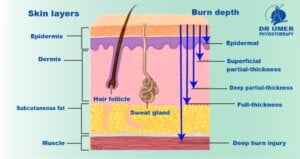Burn is a type of coagulative necrosis of tissue. Is caused by thermal application transfer from any source to body. Physiotherapy management of burn patient helps to gain independence and return to an active healthy life style.
Types of Burn
There are four types of burn;
- Superficial burn
- Superficial partial thickness burn
- Deep partial thickness burn
- Full thickness burns

Causes of Burn
Causes of burn are;
- Blast or Fire
- Hot liquid
- Electrical Current
- Sunlight
- Radiations like X-Ray
Complications
- Pathological scar
- Infections
- Neuropathy
- Hypovolemia
- Hypothermia
- Heterotopic ossification
Position
The position of comfort for the patient is usually the joint flexion unfortunately that allow scar tissue to contract and it cause deformities. Extension position is good for burns patient. Physiotherapist also suggest splint to maintain extension position or better position according to burn. Splint prevent contracture and maintain the range of motion. There are two types of splints. Static splint and Dynamic splint.
Physiotherapy Management of Burn Patient
Physical-Therapy maintain joint mobility and prevent contractures and deformities. Physiotherapist also helps to maintain soft tissue length and muscle strength. Physiotherapy prevents the immobility complications. Movement should be performed frequently to reduce edema and to reduce joint stiffness. There are many exercises for burn patient but according to the condition. Here I discuss some important joint stretching exercises.
Stretching of Finger
Start with the knuckles in the hands. Place the palm over all the fingers and help pull downwards so that your skin becomes white. Stretching the skin and tissues takes enough time to straighten. Hold it comfortably for 30 seconds. You should complete this at least three to four times every hour.
Now make a fist to combine all the joints. You will see the whiteness across the knuckles. Take a help of someone, place an entire hand over the fist and help to hold that for 30 seconds.
When the burn comes down between the web spaces of the fingers. Separate the fingers by pulling apart outwards. You can also provide a little bit of a firm pressure within that web space. Hold it then release and move on to the next fingers.
Stretching of thumb:
Take your thumb, bringing it over to your pinkie. Hold it there you can put another finger over it to give it more of a stretch. Hold that for 30 seconds then bring the thumb back out straight.
Now bend your thumb at middle knuckle joint. Hold onto the nail, this provides stability at the bottom of the thumb to get it a little bit more of a stretch. Then extend the finger downwards and spread the forefingers, the more you can do the better.
Stretching the Knee
Bend the knee straight up until the skin turns white or Blanche’s. It is important to maintain the stretch for at least 30 to 60 seconds. You can apply pressure in those areas that seem raised.
It is important to be out of bed and walking several times per day to help with early recovery. You need to be careful to avoid any trauma to newly grafted skin. Try to walk normal as possible. Stand up tall and walk heel to toe.
Massage Therapy

Physiotherapist are using a technique called scar massage. Massage is very helpful for burns patient. It helps to stimulate blood circulation and increase the healing process.
Procedure: Press on the skin until the skin blanch or turn white. Move the skin side to side in all directions like up, down and also in circles.


